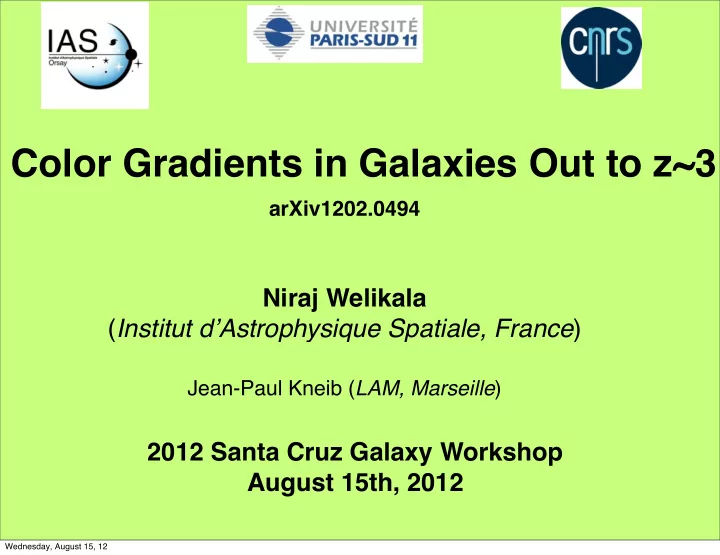

Color Gradients in Galaxies Out to z~3 arXiv1202.0494 Niraj Welikala ( Institut d’Astrophysique Spatiale, France ) Jean-Paul Kneib ( LAM, Marseille ) 2012 Santa Cruz Galaxy Workshop August 15th, 2012 Wednesday, August 15, 12
Background • Color gradients indicative of mechanisms that govern the formation and assembly of stellar populations + indicate where in the galaxy star Half light Redshift I AB mag formation is concentrated (centre radius Photometric early-type (red) versus outskirts) Ferreras et al. 2005 Photometric late-type (blue) • z<1 : SDSS galaxies in 0.01 < z < 0.17 have redder cores and steeper - Evolution of 249 field early-type galaxies in gradients in early-type than late-type GOODS-South with median z~0.7. galaxies (Gonzalez-Perez et al. 2011) - Most blue early types feature blue cores • Some studies at higher redshift with whereas most red early-types have passively relatively small samples e.g. Ferreras evolving stellar populations with red cores et al. (2005), Brok et al. (2011), Guo et (similar to local E-types). al. (2011), La Barbera et al. (2011) - Color gradients and their scatter do not evolve significantly with redshift up to z~1 & compatible with z~0 observations Wednesday, August 15, 12
The Sample • Magnitude-limited (i AB < 25.5) sample of 3248 resolved galaxies with photometric redshifts out to z~3 in GOODS-S (Giavalisco+04, Cardamone+10) after applying a selection of R50>0.3” on galaxy size • Photo-z sample complete down to z~2.5 and M I < -20.0 • Subsample of 531 galaxies with photo-z and spec-z from GOODS- VIMOS (magnitude-limited IAB<24.5, complete down to z~2 and M I < -21.0). • <R 50 >=0.45” (D 50 ~ 8 PSF FWHM(i)) (i)) Welikala & Kneib 2012 Wednesday, August 15, 12
Sample characteristics Welikala & Kneib 2012 Absolute magnitude Half light radius Sersic index -22 -20 -18 (v) Redshift Color Apparent magnitude 1 2 3 Wednesday, August 15, 12
Measuring the color gradient • Measured as difference in v-i observed color (after PSF homogenization) between (R 50 <r<2R 50 ) and r<R 50 • Radial dependence of SNR in volume- limited subsample r<2.5R 50 • At z~2-3, when galaxies are stacked, SNR=9.0 at 1.5<r<2R 50 • SNR of stack < 2.0 for r > 2.5 R 50 • Simulate disk galaxies with input color gradient and resolution to determine effect of galaxy size: for R 50 < 0.3” (D 50 < 5.5 FWHM) , fractional error exceeds 0.2: • Limit more conservative than D >1.6 FWHM used in COSMOS survey for Welikala & Kneib 2012 shape measurements (Leauthaud+07) Wednesday, August 15, 12
Results: Dependence on Galaxy Properties Fainter galaxies Core bluer relative to Weak dependence on progressively redder outskirts luminosity in outskirts Core redder relative to outskirts Core becomes redder with size Rest-frame Core becomes bluer [arcsec](i775) UV with redshift Strong color (younger dependence: stellar Redder galaxies populations) have redder cores (~ local S0/Sa) Rest-frame optical (older stellar populations) Welikala & Kneib 2012 Wednesday, August 15, 12
Results: Morphological Type Dependence Core bluer relative to outskirts Core redder relative to outskirts similar to local early- types with red cores Little evolution upto z~1: Welikala & Kneib 2012 Ferreras+05 result Wednesday, August 15, 12
Photo-z versus spec-z Core bluer relative to outskirts Core redder relative to outskirts Welikala & Kneib 2012 Wednesday, August 15, 12
The stacked color variation: Bright galaxy sample Bluer cores relative to outskirts at high redshift Color difference between centre and outskirts Welikala & Kneib 2012 becomes larger at high z (0.4 mag at z~2.5) Wednesday, August 15, 12
The Stacked color variation: Fainter sample 0.3<R50<0.4 arcsec Welikala & Kneib 2012 Wednesday, August 15, 12
Summary • Suggest bluer centers compared to outskirts • Lehnert+09 : large H α line widths observed in z~1-3 intensely star-forming galaxies driven by self- regulated SF through the mechanical energy liberated by massive stars • Intensity of SF in these distant galaxies as high as local starbursts but SF occurs on a much larger physical scale, maintained by high gas fractions & mass-surface densities Wednesday, August 15, 12
• Le Tiran+11 stacked rest-frame optical emission lines ([SII] λλ 7616,6731 and [OI] λ 6300) of ~50 color- preselected galaxies at z=1.2-2.6 with high H α surface brightnesses • Found evidence for outflows + higher gas densities (and pressures) in intensely star-forming regions compared to fainter, diffuse gas - similar values to starburst regions & diffuse ISM in nearby galaxies. • Thus: if very high gas densities are present in the centers of z>1.5 galaxies strong star formation driven by feedback & self-regulation and is concentrated in the centers could be consistent with our observed color gradient trends Wednesday, August 15, 12
PSF homogenization Basis functions • Alard (1999), Alard & Lupton (1998) • Find the kernel that matches input image to a reference image • Kernel is decomposed into a linear combination of basis functions (delta functions or Gaussians of varying FWHM) Wednesday, August 15, 12
Recommend
More recommend